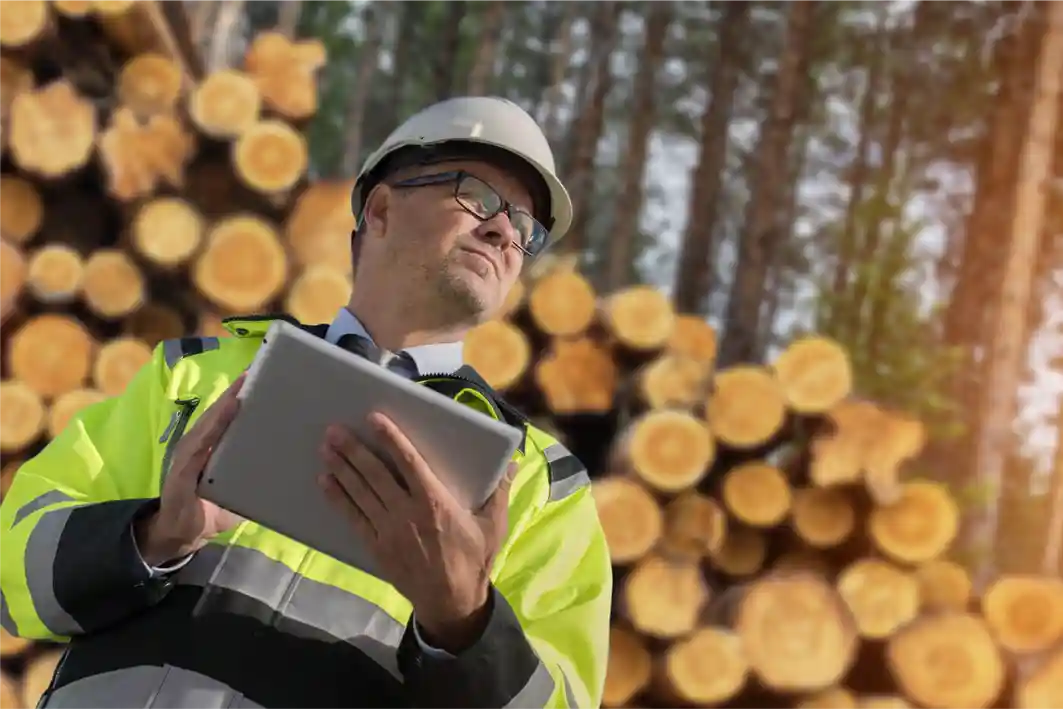Timbeter is an innovative tool, but to get the maximum benefit out of it, you must also use it correctly. Whenever we get feedback about incorrect measurements, our support team checks the results and researches the best way for clients to use our solution flawlessly.
The good news is that whenever a person or company has incorrectly used Timbeter, we give them a free trial until they get correct results.
Still, here are the ten most common reasons why first-time users fail using Timbeter. Have you made any of these common errors?
1# Lack of reference/incorrect reference setting on the screen
To get correct results, the user needs to use a reference. A reference is an object (measurement stick, measurement tape, etc.) with the minimal length of 1m (4 ft.) that user needs to place on the pile. Reference is positioned horizontally or vertically, and it must be parallel. After making the picture, the red reference line on the screen must be the same size matching the reference on the pile. Even a small mistake in setting reference can cause a wrong result.
2# The user is not standing in parallel to the pile
It is crucial for the user to make the picture standing in parallel to the pile. Any angle will distort the end-results. The same requirement also applies to panorama-pictures, where the user needs to move in parallel to the pile.
3# Weak camera
Especially in measuring small diameters from the long distance, the strength of a camera may affect the end-results. The more powerful camera, the more precise results. Our engineering-team suggests to use at least 8 Mp cameras to get accurate results.
4# Incorrect formula
Every region has its formulae for volume calculation. Each formula uses a unique method and, precisely, a unique way to calculate and also to round the numbers. Timbeter has incorporated over 12 different formulas that are used worldwide, so users need to ensure that use the correct one. What are the differences in volume measurement using different formulae we have been written earlier in our blog.
5# Wrong air filling factor/pile density coefficient
To measure pulp-and fuelwood, air filling factor/pile density coefficient that determines the amount of timber without air and bark is being used. Some regions use fixed factors/coefficients; some regions define separately for each pile. Timbeter has both options: you can measure the volume by using the set coefficient/factor, or you can use Timbeter to determine to obtain the correct factor/coefficient and get the overall volume.
6# Incorrect surface area
Timbeter enables detecting the automatic pile area contour, but sometimes some extra objects (stones, puddle, etc.) may cause false surface area. The user only needs to correct the area by drawing a loop around the area to be added (begin drawing on the inside of the contour, go outside and finish drawing on the existing contour) or vice-versa for reducing the pile area.
7# Panorama
Making panorama picture most crucial thing is to move in parallel to the pile when making photographs. Every device has a different capacity, so the suggestion for the beginners is to start with small steps and with 5-7 pictures to get the first results. Some devices enable to stitch together even up to 25 images.
8# Distance
If measuring long distance, a user may not obtain good results in log diameters detection. For larger piles, it would make sense to make the measurement from a closer distance and use the panorama-mode to stitch pictures together.
9# Poor light
Poor detection of the diameters of the logs is primarily related to inadequate light exposure. When taking an image, the user must balance the light or shadow on the sun icon in the right size. With the perfect exposure, diameters of the logs will be measured accurately.
#10 Wrong data
When making measurements, the user needs to enter the data regarding the reference size and length of logs, air filling factor, etc. This data is used to calculate the volume. Quite often it happens that information is inserted incorrectly. But is easy to correct data and re-measure the current picture with the correct data and get the accurate results.
Have you tried Timbeter and got unsatisfactory results – was any of the points listed above reason for the incorrect results? Let us know, and we’ll help you to obtain the correct results.
